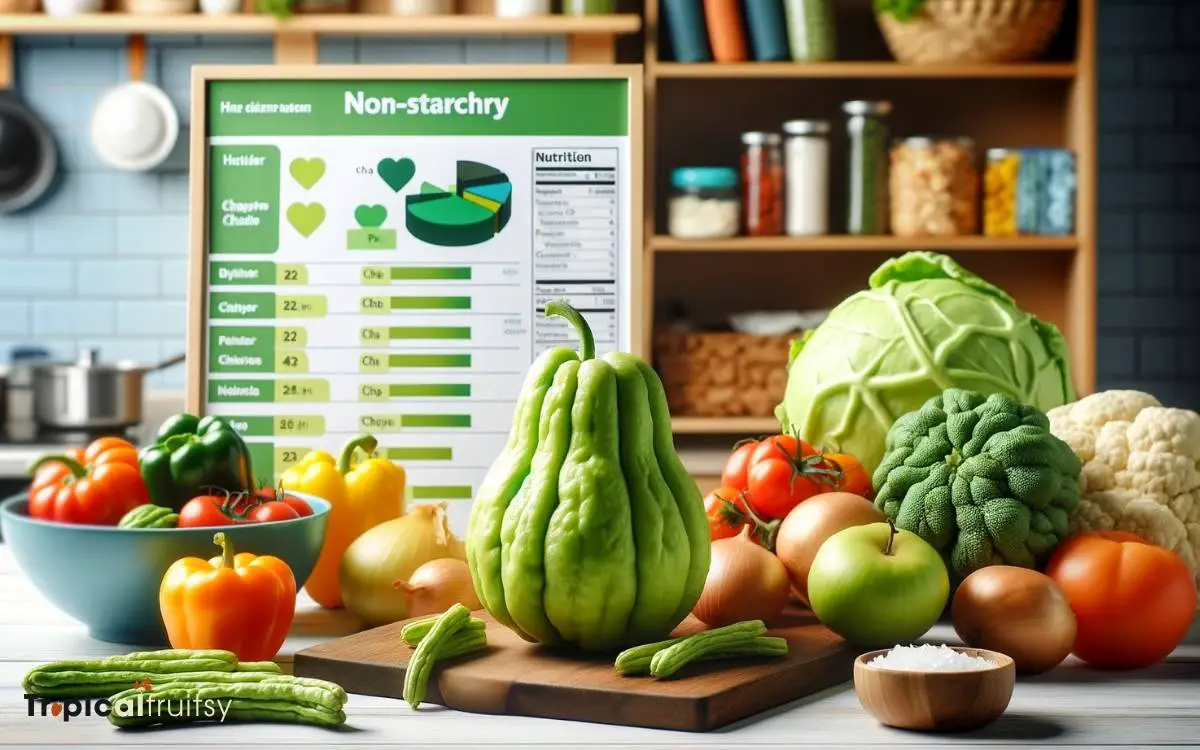Is Chayote a Starchy Vegetable? Exploring the Essence!
Chayote is not considered a starchy vegetable. Compared to typical starchy vegetables like potatoes, corn, and peas, chayote (Sechium edule) has a significantly lower starch content, making it a suitable choice for those looking to reduce their starch intake.
Starchy vegetables are known for their high carbohydrate content which can affect blood sugar levels and provide a substantial source of energy.
Chayote, on the other hand, contains minimal starch and is lower in carbohydrates.
This makes it a lighter alternative that can be included in a variety of diets:
The nutritional benefits of chayote, coupled with its culinary flexibility, make it a valuable addition to a balanced diet.
Incorporate chayote into your diet for a nutritious, low-starch option that complements a myriad of dishes.

Key Takeaway
Starch Content Comparison of Chayote with Other Vegetables
| Vegetable | Classification | Approximate Starch Content | Benefits |
|---|---|---|---|
| Chayote | Non-starchy | Low | Low in carbs, suitable for various diets |
| Potato | Starchy | High | Energy-providing, high in carbs |
| Corn | Starchy | Moderate-High | Source of energy, fiber, and vitamins |
| Peas | Starchy | Moderate | Rich in protein, fiber, and vitamins |
Understanding Chayote
Chayote, scientifically known as Sechium edule, is a gourd family member that offers a versatile, low-starch alternative to traditional root vegetables.
Its subdued flavor and crisp texture make it suitable for a variety of culinary uses, from raw salads to cooked dishes.
Nutritionally, chayote is noteworthy for its low caloric content, registering a mere 19 calories per 100 grams. This is largely because it is composed predominantly of water, accompanied by a modest carbohydrate content.
Unlike starchy vegetables, which are high in complex carbohydrates that break down into sugars, chayote features primarily non-starch polysaccharides, such as cellulose and pectin.
These contribute to its dietary fiber content, promoting satiety and gastrointestinal health without the glycemic load characteristic of starchier counterparts.
Defining Starchy Vegetables
Starchy vegetables are characterized by their high carbohydrate content, primarily in the form of starch, which serves as a key energy source within the diet.
To evaluate whether chayote is a starchy vegetable, it is crucial to compare its starch content with that of known starchy vegetables, such as potatoes, corn, and peas.
An analysis of chayote’s starch levels will provide a clear determination of its classification in the context of starchy versus non-starchy vegetables.
Starch Content Comparison
One must understand the typical starch content in vegetables to assess whether chayote falls within the category of starchy vegetables.
Starchy vegetables are characterized by a higher proportion of carbohydrates, primarily in the form of starch. Examples include potatoes, corn, and peas, which typically contain more than 15 grams of carbohydrates per 100-gram serving.
In contrast, non-starchy vegetables like broccoli, spinach, and chayote contain significantly lower amounts of starch. Chayote, specifically, offers a mere 4.5 grams of total carbohydrates per 100 grams, with only a fraction of this being starch.
This quantitative comparison highlights that chayote’s starch content is substantially lower than that of recognized starchy vegetables, positioning it outside this category from a nutritional standpoint.
Common Starchy Examples
To delineate what constitutes a starchy vegetable, it is instructive to consider common examples such as potatoes, sweet potatoes, and yams, which are known for their high carbohydrate content.
These vegetables are characterized by their dense texture and a significant presence of starch—a polysaccharide that serves as a storage form of glucose in plants.
Primary Starchy Vegetables:
- Potatoes: Rich in vitamin C, potassium, and dietary fiber.
- Sweet Potatoes: High in beta-carotene, vitamins A and C.
Secondary Starchy Vegetables:
- Yams: Contain fiber, potassium, and manganese.
- Corn: Source of B-vitamins, magnesium, and phosphorus.
Starchy vegetables offer a valuable energy source and are integral to a balanced diet. Their nutrient profiles support body functions and provide essential vitamins and minerals.
Chayote Starch Levels
Contrary to the dense carbohydrate composition found in typical starchy vegetables, chayote features a lower starch content, aligning it more closely with non-starchy varieties.
Starchy vegetables, like potatoes and corn, are known for their high levels of complex carbohydrates, which are broken down into sugars to provide energy.
In contrast, chayote squash has a significantly lower starch percentage, suggesting its potential for a reduced impact on blood glucose levels when consumed.
This characteristic renders chayote a suitable inclusion in diets that monitor carbohydrate intake, such as diabetic meal plans or weight management programs.
The nutritional profile of chayote, replete with fiber, vitamins, and minerals, further fortifies its status as a healthful option among vegetables, especially for those seeking to limit their starch consumption.
Chayote’s Nutritional Breakdown
How does the chayote’s nutritional composition contribute to its classification as a non-starchy vegetable?
Chayote, scientifically known as Sechium edule, is low in calories and rich in fiber, making it distinctively non-starchy.
Its carbohydrate content primarily consists of non-starch polysaccharides, such as dietary fiber, which promote digestive health without the rapid glucose release characteristic of starchy vegetables.
Macronutrient Profile
- Low in calories: A serving contains just 38 calories.
- Carbohydrates: Approximately 9 grams per cup, with minimal presence of starch.
- Fiber: Around 4 grams per cup, contributing to satiety and reduced blood sugar spikes.
Micronutrient Content
- Vitamins: Rich in vitamin C, B-vitamins, and folate.
- Minerals: Provides essential minerals like potassium, magnesium, and zinc.
This evidence-based analysis highlights chayote’s nutritional properties, aligning it more closely with non-starchy vegetables favored in diets managing blood sugar and weight.
Starch Content in Chayote
Regarding the starch content of chayote, it contains a negligible amount, reinforcing its classification as a non-starchy vegetable.
This characteristic is significant for those monitoring their carbohydrate intake, particularly individuals with diabetes or those following a low-carb diet.
| Nutrient | Content in Chayote |
|---|---|
| Total Carbohydrate | Low |
| Dietary Fiber | Moderate |
| Starch | Negligible |
| Sugars | Low |
| Caloric Value | Low |
The starch content is markedly low compared to vegetables like potatoes and corn, which have higher starch levels. By understanding the starch content in chayote, consumers can make informed dietary choices.
This evidence-based approach aligns with the nutritional analysis that categorizes chayote as a beneficial addition to a balanced diet.
As we delve into comparisons, it becomes clear how chayote’s starch content stands out among other vegetables.
Comparing Chayote to Other Vegetables
When assessing chayote’s place within the spectrum of vegetables, it is crucial to consider its nutrient profile in relation to its peers.
Chayote’s unique composition provides a lower starch content compared to tuberous vegetables like potatoes and yams, while offering a distinct, crisp texture and a subtly sweet flavor that contrasts with more robust, earthy vegetables.
This comparison can illuminate chayote’s potential health benefits and culinary uses within a balanced diet.
Nutrient Content Comparison
While chayote is a low-starch vegetable, its nutrient profile contrasts with that of other common vegetables, such as potatoes and corn, which contain higher amounts of carbohydrates.
To understand the differences, consider the following nutrient content comparisons:
Chayote:
- Low in calories: approximately 19 kcal per 100g
- Provides essential vitamins: notably vitamin C and B-vitamins
- Contains important minerals: such as potassium and magnesium
Higher-starch vegetables (like potatoes and corn):
- Higher in calories: potatoes at 77 kcal and corn at 86 kcal per 100g
- Rich in carbohydrates: about 17g in potatoes and 19g in corn per 100g
- Offer different vitamin and mineral profiles: higher in vitamin B6 and folate in potatoes, while corn provides thiamin and phosphorus
This analytical comparison demonstrates that chayote’s nutrient composition is distinct from starchy counterparts, featuring fewer calories and carbohydrates but providing a unique set of vitamins and minerals.
Texture and Flavor Contrast
Moving beyond nutritional content, chayote’s crisp texture and mild flavor set it apart from the creaminess of potatoes and the sweetness of corn. This distinction is crucial when considering its role in a balanced diet.
Chayote, a gourd family member, offers a unique combination of low calorific value and high water content, which contributes to its refreshing crunchiness.
Unlike starchy vegetables that undergo textural changes upon cooking, transforming into soft or fluffy consistencies, chayote maintains a firm structure, providing a contrasting mouthfeel in culinary applications.
Its subtle taste, unlike the robust flavors of root vegetables, allows it to absorb seasonings and harmonize with a multitude of ingredients, thereby enhancing dietary variety without overpowering the palate.
Health Benefits of Chayote
The chayote, a non-starchy vegetable, offers a variety of health benefits due to its rich nutrient profile.
This gourd family member is endowed with essential vitamins and minerals, contributing to overall health and wellness when included in a balanced diet. Notably, chayote is low in calories while still providing a substantive amount of nutrients.
Nutrient Density:
- High in vitamin C, an antioxidant that supports immune function.
- Contains vitamin B6, which aids in metabolism and brain health.
Dietary Benefits:
- Soluble fiber content promotes digestive health and can help regulate blood sugar levels.
- Low-calorie count makes it a beneficial addition for weight management strategies.
Analyzing chayote’s components reveals its potential in supporting a healthy lifestyle, especially when considering its contribution to vital bodily functions and disease prevention.
Incorporating Chayote Into Your Diet
Chayote’s versatility in the kitchen makes it an easy addition to a myriad of dishes, enhancing meals with its mild flavor and crisp texture while bolstering nutritional content.
This non-starchy vegetable is low in calories and rich in dietary fiber, vitamins C and B, and essential minerals like zinc and potassium, contributing to a balanced diet.
Its subtle taste complements rather than overpowers other ingredients, allowing it to be seamlessly integrated into salads, stir-fries, soups, and stews.
Analytically, chayote’s high water and fiber content promote satiety and digestive health, making it a suitable choice for weight management and metabolic health.
Nutritionally, its inclusion in regular diets can support overall wellness, as it provides necessary nutrients without excessive carbohydrates or calories.
Chayote in Culinary Uses
In culinary practices, chayote’s adaptability is showcased through its role as a staple in various ethnic cuisines, where it is prized for its ability to absorb a spectrum of flavors and contribute a pleasant crunch to dishes.
Preparation Methods:
- Raw: Sliced thinly in salads, it offers a crisp texture and a mild taste, providing dietary fiber without excessive carbohydrates.
- Cooked: Whether steamed, boiled, or sautéed, chayote retains some of its firmness, adding volume and nutrients like vitamin C to stews and stir-fries.
The nutritional profile of chayote, low in starch and calories yet rich in micronutrients, makes it an excellent choice for health-conscious cooking. Its versatility in recipes is matched by its potential benefits in supporting a balanced diet.
Conclusion
The chayote, with its low starch content and rich array of nutrients, offers a healthful alternative to starchy vegetables. It contributes to a balanced diet, providing essential vitamins and minerals while supporting dietary diversity.
The compelling statistic that a chayote contains only 3.9 grams of carbohydrates per 100 grams highlights its role as a beneficial inclusion in diets aimed at managing blood sugar levels and reducing carbohydrate intake.






